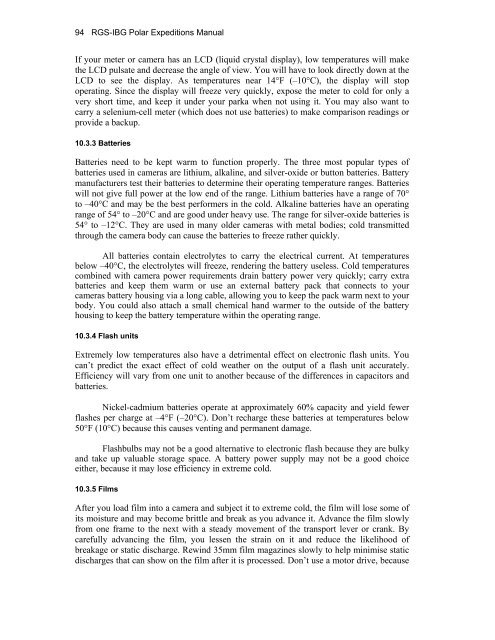Edited by Rachel Duncan 4th Edition ISBN 0-907649-91-2 London ...
Edited by Rachel Duncan 4th Edition ISBN 0-907649-91-2 London ...
Edited by Rachel Duncan 4th Edition ISBN 0-907649-91-2 London ...
You also want an ePaper? Increase the reach of your titles
YUMPU automatically turns print PDFs into web optimized ePapers that Google loves.
94 RGS-IBG Polar Expeditions Manual<br />
If your meter or camera has an LCD (liquid crystal display), low temperatures will make<br />
the LCD pulsate and decrease the angle of view. You will have to look directly down at the<br />
LCD to see the display. As temperatures near 14°F (–10°C), the display will stop<br />
operating. Since the display will freeze very quickly, expose the meter to cold for only a<br />
very short time, and keep it under your parka when not using it. You may also want to<br />
carry a selenium-cell meter (which does not use batteries) to make comparison readings or<br />
provide a backup.<br />
10.3.3 Batteries<br />
Batteries need to be kept warm to function properly. The three most popular types of<br />
batteries used in cameras are lithium, alkaline, and silver-oxide or button batteries. Battery<br />
manufacturers test their batteries to determine their operating temperature ranges. Batteries<br />
will not give full power at the low end of the range. Lithium batteries have a range of 70°<br />
to –40°C and may be the best performers in the cold. Alkaline batteries have an operating<br />
range of 54° to –20°C and are good under heavy use. The range for silver-oxide batteries is<br />
54° to –12°C. They are used in many older cameras with metal bodies; cold transmitted<br />
through the camera body can cause the batteries to freeze rather quickly.<br />
All batteries contain electrolytes to carry the electrical current. At temperatures<br />
below –40°C, the electrolytes will freeze, rendering the battery useless. Cold temperatures<br />
combined with camera power requirements drain battery power very quickly; carry extra<br />
batteries and keep them warm or use an external battery pack that connects to your<br />
cameras battery housing via a long cable, allowing you to keep the pack warm next to your<br />
body. You could also attach a small chemical hand warmer to the outside of the battery<br />
housing to keep the battery temperature within the operating range.<br />
10.3.4 Flash units<br />
Extremely low temperatures also have a detrimental effect on electronic flash units. You<br />
can’t predict the exact effect of cold weather on the output of a flash unit accurately.<br />
Efficiency will vary from one unit to another because of the differences in capacitors and<br />
batteries.<br />
Nickel-cadmium batteries operate at approximately 60% capacity and yield fewer<br />
flashes per charge at –4°F (–20°C). Don’t recharge these batteries at temperatures below<br />
50°F (10°C) because this causes venting and permanent damage.<br />
Flashbulbs may not be a good alternative to electronic flash because they are bulky<br />
and take up valuable storage space. A battery power supply may not be a good choice<br />
either, because it may lose efficiency in extreme cold.<br />
10.3.5 Films<br />
After you load film into a camera and subject it to extreme cold, the film will lose some of<br />
its moisture and may become brittle and break as you advance it. Advance the film slowly<br />
from one frame to the next with a steady movement of the transport lever or crank. By<br />
carefully advancing the film, you lessen the strain on it and reduce the likelihood of<br />
breakage or static discharge. Rewind 35mm film magazines slowly to help minimise static<br />
discharges that can show on the film after it is processed. Don’t use a motor drive, because

















